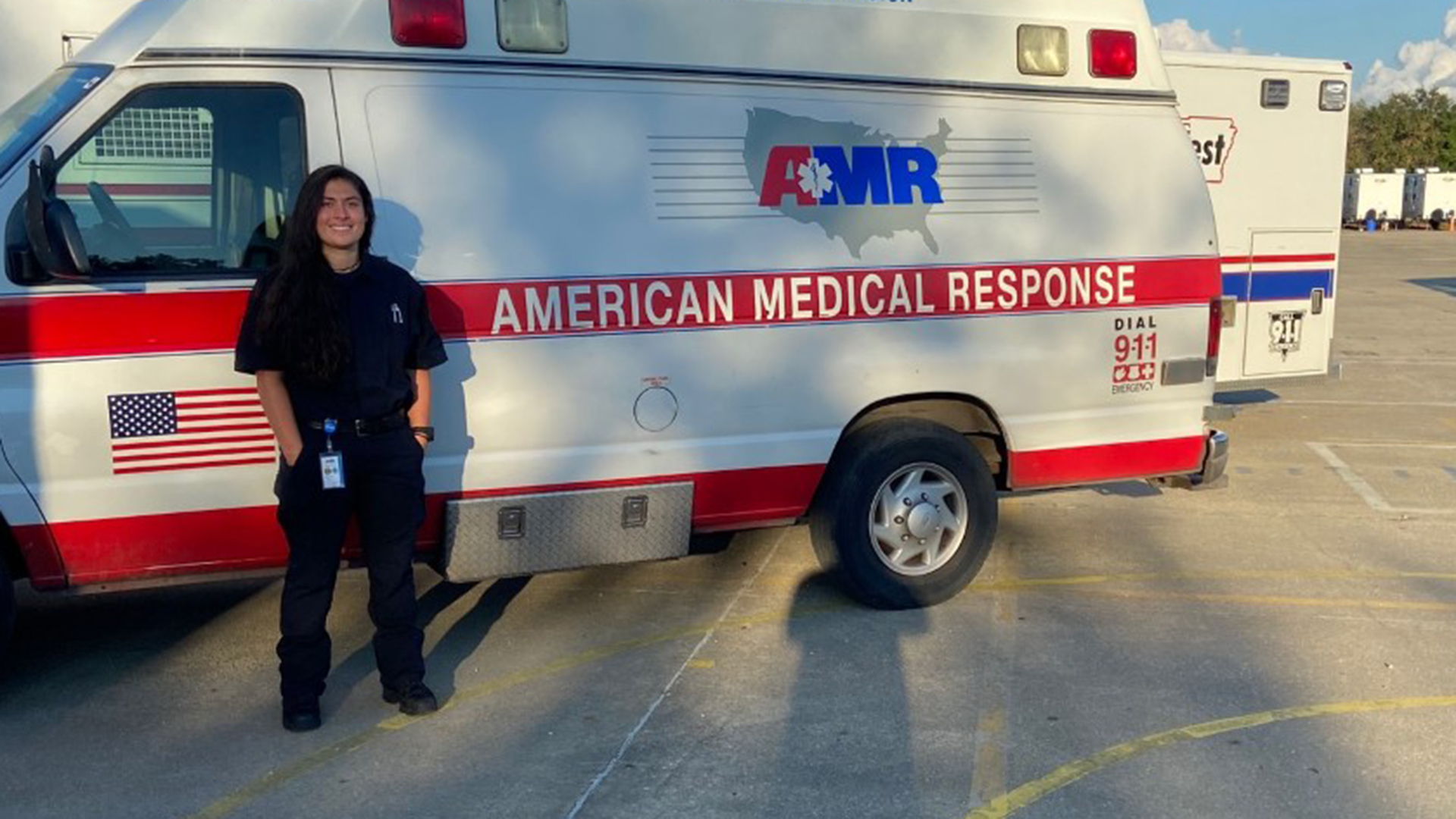Intervening in the Wake of Ida
September 28, 2021
Sometimes medical care isn’t the only thing needed to serve people in crisis.
When EMT Alexis Corini left American Medical Response (AMR) San Mateo County to join other first responders across the country to help provide emergency medical services to the Gulf Coast states, she wasn’t sure what to expect. Hurricane Ida, a Category 4 hurricane, would be her first-ever deployment.
The storm was anticipated to make landfall along the Gulf on the 16th anniversary of Hurricane Katrina. And in terms of force, it was predicted to be one of the strongest storms ever recorded. Ida came onshore as the second-most damaging hurricane to ever hit the state of Louisiana. The storm brought catastrophic flooding, sustained winds of 150 (mph) and caused almost $50 billion in damage.
Just hours after Ida made landfall, Corini touched down in Atlanta, Georgia. Upon arrival, she would head to her first assignment. She would need to pick up an ambulance and be assigned a partner. Once she had a partner and a vehicle, Corini would begin the nearly 8-hour drive to southeast Louisiana.
“When we left Georgia, we were among 81 other ambulances heading to their operating bases,” said Corini. “It was almost an even split. Around 36 teams were heading to Mississippi, and the other 45 were heading to Louisiana along with us.”
She spent her first few days in the pelican state running patient evacuation missions. After almost 36 hours of taking patients to local medical evacuation centers, hospitals, or nearby shelters, Corini and her partner were reassigned to the city of New Orleans.
“We were sent to assist at the convention center in New Orleans,” said Corini. “They had opened a medical needs shelter at the convention center, and they wanted teams from AMR assigned to help with transporting patients to area hospitals if needed.”
Corini and her partner worked 12-hour shifts for the entire time the shelter was operational, and they worked alongside teams from a variety of organizations.
“Working at the shelter was a very cool experience,” said Corini. “The shelter was opened and operated by a disaster medical assistance team, but there were teams from the Louisiana National Guard, Louisiana State Troopers and lots of military medical personnel.”
While Corini and her partner were tasked with transporting patients to area hospitals for treatment, they also provided care of another kind.
“We were lucky to have the opportunity to interact with patients outside of our normal care setting,” said Corini. “Especially with the non-critical patients in the shelter, we got the chance to build relationships with them through conversation and just playing cards. It was a very cool experience.”
As for how she feels about her very first deployment, Corini shared that while it differs from her usual work at AMR San Mateo County, there is satisfaction and a sense of gratification in knowing that you are there to help do whatever is needed. Whether it’s providing high quality patient care, lending an ear to a new friend, or passing the time playing cards for a few hours between shifts — you helped.
The storm was anticipated to make landfall along the Gulf on the 16th anniversary of Hurricane Katrina. And in terms of force, it was predicted to be one of the strongest storms ever recorded. Ida came onshore as the second-most damaging hurricane to ever hit the state of Louisiana. The storm brought catastrophic flooding, sustained winds of 150 (mph) and caused almost $50 billion in damage.
Just hours after Ida made landfall, Corini touched down in Atlanta, Georgia. Upon arrival, she would head to her first assignment. She would need to pick up an ambulance and be assigned a partner. Once she had a partner and a vehicle, Corini would begin the nearly 8-hour drive to southeast Louisiana.
“When we left Georgia, we were among 81 other ambulances heading to their operating bases,” said Corini. “It was almost an even split. Around 36 teams were heading to Mississippi, and the other 45 were heading to Louisiana along with us.”
She spent her first few days in the pelican state running patient evacuation missions. After almost 36 hours of taking patients to local medical evacuation centers, hospitals, or nearby shelters, Corini and her partner were reassigned to the city of New Orleans.
“We were sent to assist at the convention center in New Orleans,” said Corini. “They had opened a medical needs shelter at the convention center, and they wanted teams from AMR assigned to help with transporting patients to area hospitals if needed.”
Corini and her partner worked 12-hour shifts for the entire time the shelter was operational, and they worked alongside teams from a variety of organizations.
“Working at the shelter was a very cool experience,” said Corini. “The shelter was opened and operated by a disaster medical assistance team, but there were teams from the Louisiana National Guard, Louisiana State Troopers and lots of military medical personnel.”
While Corini and her partner were tasked with transporting patients to area hospitals for treatment, they also provided care of another kind.
“We were lucky to have the opportunity to interact with patients outside of our normal care setting,” said Corini. “Especially with the non-critical patients in the shelter, we got the chance to build relationships with them through conversation and just playing cards. It was a very cool experience.”
As for how she feels about her very first deployment, Corini shared that while it differs from her usual work at AMR San Mateo County, there is satisfaction and a sense of gratification in knowing that you are there to help do whatever is needed. Whether it’s providing high quality patient care, lending an ear to a new friend, or passing the time playing cards for a few hours between shifts — you helped.

.jpg)